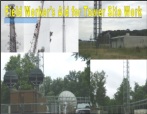Podcast: Play in new window | Download | Embed
Subscribe: Apple Podcasts | RSS
I really appreciate all of the feedback. One of the posts that I got a lot of feedback on was “Tower Injuries: Is this the Price of doing Business?” I found out that the wireless community in general is fired up about the need for change in this industry! Not only the perception that it’s dangerous but the fact that we should be doing better. There is a not only a need for change, but the industry will get a black eye because it’s going to become a type of “US” and “THEM” mentality in wireless. What I mean by that is there will be the large customers, like the carriers, who will be the “THEM” looking to keep deployments as cheap as possible and the “US” which is the climber who puts his/her life at risk trying to get the tower completed in less time regardless of the risk.
Hey, don’t forget to sign up for my monthly newsletter over there on the top right. > > >
Also, I have a Wade4Wireless products page where I have more information on my new SOW training package and I released an audiobook for my Tower Climbing: An Introduction eBook. I have a free eBook for the SOW Overview if you’re interested.
What we need to do is change the perception that the tower side of the industry is too dangerous to work and get it back to a highly respected profession where accidents may happen but are not common. The past 2 years are poor examples of safety. You know what I am talking about, not only the deaths but the injuries and near misses. Injury and death should not be the price of doing business in any industry. We are working harder to make this change, but it will take a team effort from all sides and especially from you! Each of you can help by spreading the word and becoming living examples of what to do the right way!
So, here is the feedback. I will have the comment and then my response. Just to be clear, all of these are responses from “Tower Injuries: Is this the Price of doing Business?” I remove the names to prevent any harassment, but if you include a company name I will print it.
Comment: Hi Wade, The comment was meant towards Sprint, Verizon and AT&T. The major companies that contract out the work so they don’t have to pay Union scale wages to their employees. But I agree as the one it was said to about everything you wrote.
Response: Thank you.
Comment: This fatalistic approach has no place in a safety culture. No level of accidents, much less deaths, should be acceptable.
Response: I agree whole heartedly!
Comment: Great article. I experience a lot of “deadlines” or “it has to be done” situations. There are better ways to send guys out in the morning without turning it into a race. I am 15+yrs into telecommunications industry. I take a laid back and still be safe point view with my crew and it works. Also the quality of work is excellent.
Response: It is great to see that someone can relax and pay attention to the deployment itself rather than the dead lines that often overcome many of us.
Comment: If you have never worked as an installer on one of these towers, you cannot understand how difficult it is to perform the tasks required to do a job. The owners, designers and producers of these towers are simply designing towers to support the antennas and lines, without any thought as to how they will be erected and maintained. (Other than step-bolts which are a major contributor to the fatalities.) In comparison, look at the U.S. Forest Service towers. Has there ever been an accident where a forest service worker fell from a tower? If there was, I never heard about it and these towers have been around much longer than communication towers. The service was astute enough to provide a safe workplace for their employees.
Response: I don’t know about the Forest Service tower injuries, I couldn’t find any, but I agree completely that the tower should be made as safe as possible. When climbing there are so many physical obstacles in the way and there are not always descent tie off points. Some people don’t understand what I mean by that but you may need to wrap the lanyard around something to get a tie off point because it may be the only thing to connect the lanyard too. It could be an oversized cross beam or a large leg. Especially since we all know that the climbing pegs are not an acceptable tie off point. I find that companies that are tower owners only seemed concerned with the tie off points if they have their people climbing all the towers. This is when it becomes a concern. 100% tie off is a lot easier when there are well planned and accessible tie off points that are clean without sharp edges.
Comment: Hi Wade. There are aspects of life this side of the pond where we have a surfeit of legislation and it suffocates us, but when it comes to H&S in mobile comms. I am glad we have tight legislation, prescriptive regulations and significant penalties for companies and individuals that do not comply. I work for a large tower co (JV between two carriers) and compliance with our Construction, Design and Management Regs is absolute and audited, and it underpins an uncompromising approach to working safe and staying safe.
It is frightening in any civilized country that injuries and fatalities might even flippantly be said to be the price of doing business, or perhaps to be viewed as in some way inevitable in delivery of rollout and upgrade projects to time and/or to budget. It’s time we replaced the triangle of contention between time, cost and quality handmade it a pyramid with H&S no longer a silent factor.
Finally well done on having a blog and a LinkedIn page that call this out.
Regards
Response: Thank you for the comments and it shows us how not all regulation is bad. Unfortunately here in the states big companies generally set regulation until there are too many accidents.
Comment: Every accident is preventable. That is not a safety slogan but an actual fact. The problem is that safety costs more than a lot of employers and/or their employees want to pay. In this business (tower work) you don’t get off easy when you make a mistake. Serious injury and death are the regrettable results when mistakes happen in an elevated position.
Take a closer look at the photo above. Do you see all of those cable connections on the bottom of the antennas and radio heads that are inaccessible unless someone suspends themselves from the tower/platform mount? How much would it cost to relocate those connections to positions above the bottom of the platform to afford a safer and efficient work position? Why continue to put good people in harm’s way to do their work?
Safety starts on the drawing board of every product and every project. If not, the risk to workers greatly increases and the opportunities for serious accidents go up accordingly. It is time to re-engineer our approach to safety in the wireless industry!
Response: I could not agree more! However, it is not thought of end to end. I tried to bring this up before but it seems that there is no alignment from the beginning so it is mostly put on the climber. When I say from the beginning, we should start when new towers are constructed. They can’t be prepared for everything as technologies change, (who knew we would hang all the radio heads on the tower?), but the tie off points could be prepared better. When the equipment is hung on the tower it should be thought out so when work is done it can be easily maintained, but it is not. I worked on transmitters years ago where they were trying to get the unit to fit in a small space. It fit in a small space up until you had to work on it. Then you had to pull it out from the tight spot, hoping not to affect the connected coax and you had to practically pull it apart to work on the most common failures. Not to mention all the tools you needed, it had nut, screws that need a flat, Philip, Torx and more just to work on it. They improved that side by making everything modular at first, now they replace an entire unit when it has problems. But the climber has more and more work on the tower, in the air, at height. They have to learn fiber skills, coax skills, climbing skills, safety skills, and more. Yet, when something happens people always say, well they should have done this or that, not accounting for all the issues they have to contend with. When something bad happens, most people look at the end, not the beginning to end. How many times has OSHA said, “Well the RRH should have been mounted elsewhere” or “why didn’t the tower owner provide proper climbing tie off points”?
If you have an opinion, tell me about it!
I thought you guys may want to get more training, here is a good antenna tutorial.
Antenna tutorial http://www.comsoc.org/form/tutorial-registration-antenna-basics#.VGiNsOXkjUM.linkedin
Want to support a tower climber’s family or a climber in need? Here’s how. Support Hubble, they need it now more than ever!!
Get on iTunes for Wade4wireless and write a review now! Listen please!
Guess what?!! I have finished the tutorial for the SOW.
I also have books!




























